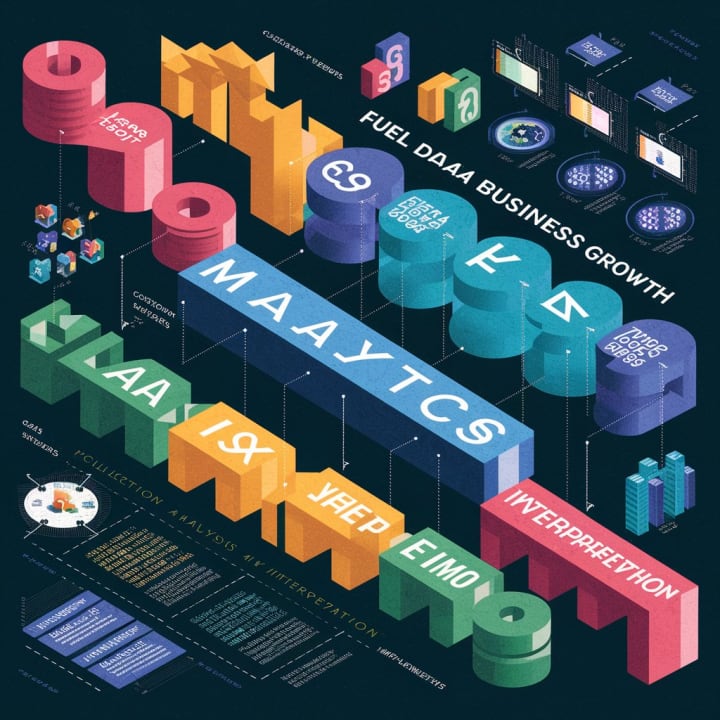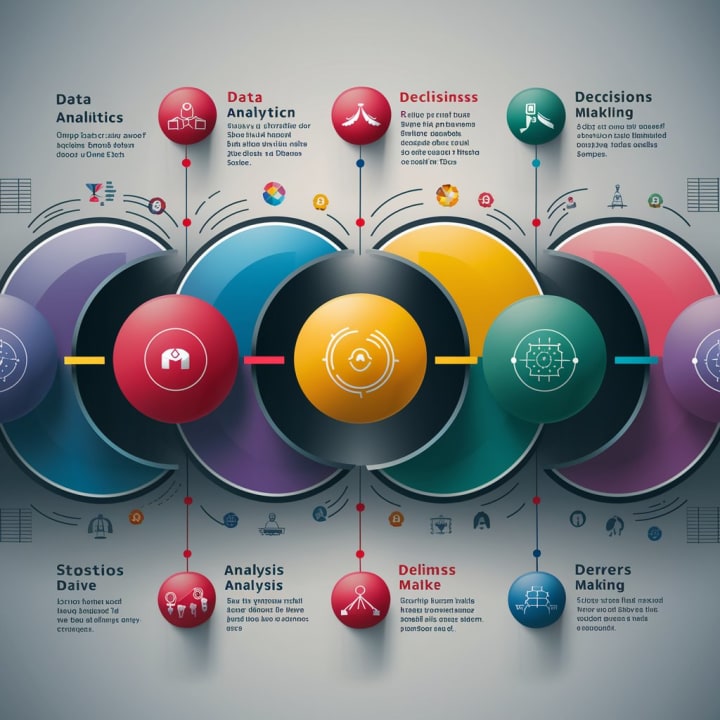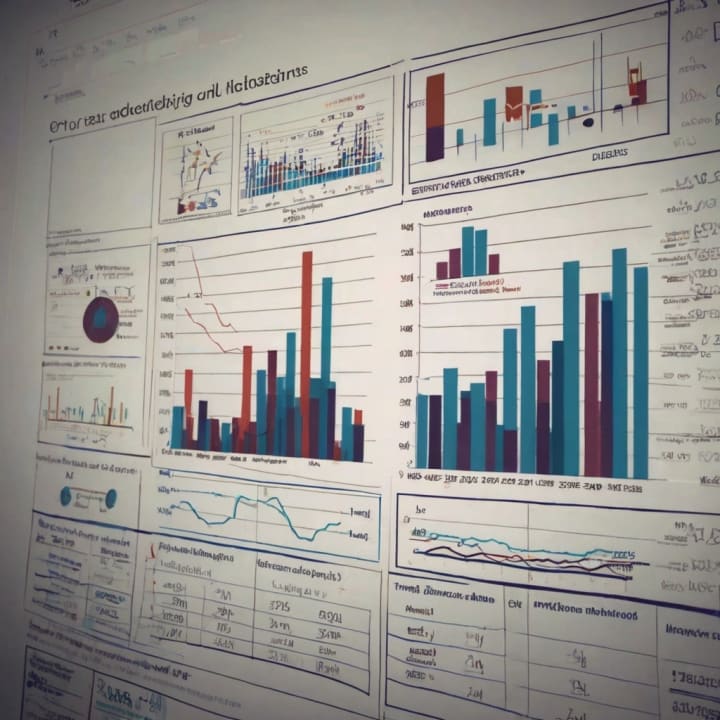How to Use Data Analytics to Drive Business Growth.
Leverage Data Insights for Strategic Decision-Making.

In today's competitive business landscape, leveraging data analytics is crucial for driving growth and staying ahead of the competition. Data analytics provides valuable insights that can inform strategic decision-making, optimize operations, enhance customer experiences, and ultimately drive business growth.
This comprehensive guide will explore how to effectively use data analytics to propel your business forward.
Understanding Data Analytics
Data analytics involves examining raw data to draw meaningful conclusions and insights. By utilizing various techniques, including statistical analysis, machine learning, and predictive modeling, businesses can uncover patterns, trends, and relationships within their data.
Types of Data Analytics
1. Descriptive Analytics: Summarizes historical data to understand what has happened in the past.
2. Diagnostic Analytics: Examines data to determine why something happened.
3. Predictive Analytics: Uses historical data and algorithms to forecast future outcomes.
4. Prescriptive Analytics: Recommends actions based on data-driven insights to achieve desired outcomes.

Benefits of Using Data Analytics for Business Growth
Utilizing data analytics offers numerous benefits that contribute to business growth:
1. Informed Decision-Making: Data analytics provides actionable insights, enabling businesses to make informed decisions based on facts rather than intuition.
2. Improved Operational Efficiency: By analyzing operational data, businesses can identify inefficiencies and streamline processes to reduce costs and increase productivity.
3. Enhanced Customer Experience: Understanding customer behavior and preferences through data analysis allows businesses to personalize their offerings and improve customer satisfaction.
4. Competitive Advantage: Leveraging data analytics gives businesses a competitive edge by uncovering market trends and identifying opportunities for growth.
5. Risk Management: Predictive analytics can help businesses anticipate and mitigate risks, leading to more stable and sustainable growth.

Steps to Implement Data Analytics for Business Growth
1. Define Clear Objectives
Before diving into data analytics, it's essential to define clear business objectives. Identify specific goals you aim to achieve, such as increasing sales, improving customer retention, or optimizing marketing campaigns. Clear objectives provide a focused direction for your data analytics efforts.
2. Collect and Integrate Data
Gather data from various sources, including customer transactions, website interactions, social media, and internal systems. Integrate these data sources to create a comprehensive dataset that provides a holistic view of your business.
3. Clean and Prepare Data
Data cleaning and preparation are critical steps to ensure the accuracy and reliability of your analysis. Remove duplicates, correct errors, and handle missing values to improve data quality. Well-prepared data leads to more accurate insights and better decision-making.
4. Choose the Right Tools and Technologies
Select the appropriate tools and technologies for your data analytics needs. Popular options include:
- Business Intelligence (BI) Tools: Tools like Tableau, Power BI, and Looker offer user-friendly interfaces for data visualization and reporting.
- Data Management Platforms: Platforms like Hadoop and Spark enable efficient data processing and storage.
- Machine Learning Frameworks: Tools like TensorFlow and Scikit-Learn facilitate advanced predictive and prescriptive analytics.
5. Analyze Data to Extract Insights
Apply relevant analytical techniques to your data to extract valuable insights. Use descriptive analytics to understand past trends, diagnostic analytics to identify root causes, predictive analytics to forecast future outcomes, and prescriptive analytics to recommend actions.
6. Visualize Data for Better Understanding
Visualizing data through charts, graphs, and dashboards makes it easier to interpret and communicate insights. Data visualization tools help stakeholders quickly grasp complex information, facilitating better decision-making.
7. Implement Data-Driven Strategies
Translate data insights into actionable strategies. For example:
- Marketing: Use customer segmentation and behavior analysis to create targeted marketing campaigns.
- Sales: Leverage predictive analytics to identify potential leads and optimize sales strategies.
- Operations: Implement process improvements based on operational data analysis.
8. Monitor and Evaluate Results
Regularly monitor the outcomes of your data-driven strategies. Evaluate performance against predefined metrics and KPIs to assess the effectiveness of your initiatives. Continuous monitoring and evaluation enable you to refine your strategies for ongoing improvement.

Practical Applications of Data Analytics for Business Growth
1. Enhancing Customer Insights
Understanding customer behavior is vital for tailoring products and services to meet their needs. Use customer analytics to analyze purchasing patterns, preferences, and feedback. This information can help you:
- Develop personalized marketing campaigns.
- Improve customer service and support.
- Enhance product development based on customer preferences.
2. Optimizing Marketing Campaigns
Data analytics can significantly improve the effectiveness of your marketing efforts. Analyze campaign performance data to identify what works and what doesn’t. Use these insights to:
- Allocate marketing budgets more efficiently.
- Target the right audience with personalized messages.
- Increase conversion rates and ROI.
3. Streamlining Operations
Analyze operational data to identify bottlenecks and inefficiencies in your processes. Streamlining operations can lead to cost savings and increased productivity. For example:
- Use predictive maintenance to prevent equipment failures.
- Optimize supply chain management to reduce delays and costs.
- Implement data-driven inventory management to avoid stockouts and overstocking.
4. Enhancing Financial Performance
Financial analytics helps businesses gain deeper insights into their financial performance. Analyze financial data to:
- Identify profitable products and services.
- Optimize pricing strategies based on market trends.
- Improve cash flow management and reduce financial risks.
5. Driving Innovation
Data analytics can spur innovation by uncovering new opportunities and trends. Analyze market data, customer feedback, and industry trends to:
- Develop innovative products and services.
- Identify emerging markets and growth opportunities.
- Stay ahead of competitors by anticipating industry shifts.

Overcoming Challenges in Data Analytics Implementation
Implementing data analytics comes with its set of challenges. Here are some common obstacles and how to overcome them:
1. Data Privacy and Security
With the increasing amount of data collected, ensuring data privacy and security is paramount. Implement robust data protection measures, including encryption, access controls, and compliance with data protection regulations like GDPR and CCPA.
2. Data Quality Issues
Poor data quality can lead to inaccurate insights and misguided decisions. Invest in data cleaning and preparation processes to ensure your data is accurate, complete, and reliable.
3. Lack of Skilled Personnel
Finding and retaining skilled data analysts and data scientists can be challenging. Invest in training and development programs to upskill your existing workforce. Additionally, consider partnering with external experts or consulting firms for specialized expertise.
4. Integrating Data from Multiple Sources
Integrating data from various sources can be complex and time-consuming. Use data integration tools and platforms that facilitate seamless data consolidation and create a unified data view.
5. Resistance to Change
Implementing data analytics often requires a cultural shift within the organization. Overcome resistance by:
- Communicating the benefits of data-driven decision-making.
- Providing training and support to employees.
- Demonstrating quick wins to build confidence in data analytics initiatives.

Future Trends in Data Analytics
Stay ahead of the curve by keeping an eye on emerging trends in data analytics. Some key trends to watch include:
1. Artificial Intelligence and Machine Learning
AI and machine learning are revolutionizing data analytics by enabling more sophisticated predictive and prescriptive analytics. These technologies can uncover deeper insights and automate decision-making processes.
2. Big Data Analytics
As the volume of data continues to grow, big data analytics will become increasingly important. Advanced analytics techniques will be required to process and analyze vast amounts of data quickly and efficiently.
3. Real-Time Analytics
Real-time analytics allows businesses to gain insights and make decisions instantly. This is particularly valuable in dynamic industries like e-commerce, finance, and healthcare, where timely information is critical.
4. Data Governance and Ethics
With the increasing focus on data privacy and security, data governance and ethics will play a crucial role in data analytics. Businesses must ensure responsible and ethical use of data to build trust with customers and stakeholders.
5. Augmented Analytics
Augmented analytics leverages AI and machine learning to automate data preparation, analysis, and visualization. This enables even non-technical users to gain insights and make data-driven decisions.

Conclusion: Embrace Data Analytics for Business Growth
Data analytics is a powerful tool that can drive business growth by providing actionable insights for strategic decision-making.
By understanding the benefits, implementing the right strategies, and staying abreast of emerging trends, businesses can unlock the full potential of their data. Embrace data analytics to optimize operations, enhance customer experiences, and achieve sustainable growth in today's competitive market.

#DataAnalytics, #BusinessGrowth, #StrategicDecisionMaking, #DataDrivenInsights, #CustomerAnalytics, #OperationalEfficiency, #FinancialPerformance, #Innovation, #DataPrivacy, #AIandML, #BigData, #RealTimeAnalytics, #DataGovernance, #AugmentedAnalytics
About the Creator
Sherif Saad
Hey there, fellow word enthusiasts! I'm Sherif, and I'm thrilled to embark on this creative journey with you
I'm a passionate writer with a love for storytelling that knows no bounds diving into the world of words.
Enjoyed the story? Support the Creator.
Subscribe for free to receive all their stories in your feed. You could also pledge your support or give them a one-off tip, letting them know you appreciate their work.






Comments (1)
Wonderful, it effectively highlights the importance of leveraging data insights in today's competitive landscape, by explaining the different types of data analytics, the benefits outlined, such as informed decision-making, improved operational efficiency, enhanced customer experience, competitive advantage, and risk management, underscore the immense value that data analytics, your guide serves as a valuable resource, thank you very much, and have a great weekend!